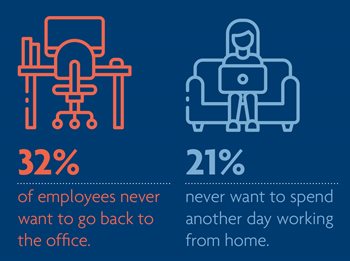NEWS
Tuesday 15 June 2021
After the early months of 2020 saw millions swap daily commutes, busy workplaces and face-to-face meetings for working from home and communicating via video calls and email, the early months of 2021 have seen vaccination programmes begin in many countries, programmes that now seem to be helping control the spread of the virus and the risk of serious illness.
So, as much of the world starts to return to some form of normality after almost 18 months that saw our work and personal lives turned upside down, the big question looming over employers is what the workplace should and will look like going forward. New ways of working are being discussed at every multinational company.
Whether opting for a full return to the workplace, a hybrid/flexible/voluntary model or a completely remote workforce, employers are thinking long and hard about what will work best for their employees, their productivity and their bottom line, without having any negative impact on physical and mental wellbeing.
Working practices that seemed new and strange a year ago, are now completely normal and yet, as workplaces fully reopen, we need to change many of them again. This can be difficult, and employees might be reluctant to embrace more change as well as being concerned about safety with new variants of the virus offering new, unknown threats.
What are some of the different approaches multinational employers are adopting? How do they help with the challenges employees might face in adapting to yet more change and how can employee benefits offer support with this tough balancing act?
Flexible and hybrid vs return to the workplace
 While some companies had adopted flexible and hybrid working models before the pandemic, it’s clear that COVID-19 has changed the way we think about remote working. The enforced shift in working practices turbo-charged the trend towards adopting new ways of working for vast numbers of office-based employers – especially for many large tech companies. Salesforce, for instance, which employs 54,000 people worldwide, has said it will let staff all work from home for at least some of the time, joining the likes of Twitter and Facebook committing to remote workforces.1
While some companies had adopted flexible and hybrid working models before the pandemic, it’s clear that COVID-19 has changed the way we think about remote working. The enforced shift in working practices turbo-charged the trend towards adopting new ways of working for vast numbers of office-based employers – especially for many large tech companies. Salesforce, for instance, which employs 54,000 people worldwide, has said it will let staff all work from home for at least some of the time, joining the likes of Twitter and Facebook committing to remote workforces.1
In contrast, some companies seem more eager to return to more traditional working patterns – perhaps reflecting their culture and practices. Goldman Sachs, for example, has told its staff in the UK and the US to be ready to return to the office as soon as the Government lifts social contact restrictions.2
Whether planning to be back in the office on a full-time or a flexible basis, some of the most common questions employees will be asking is “do I have to?” and “is it safe to do so?”. Across Europe, June was seen as the month most likely to see large numbers of office workers return to the workplace according to research among workers in the UK, France, Germany, Spain and Italy back in Feb 2020,1 and now it seems that this may well be the case as vaccination programmes start to take effect and many employees crave social interaction.
However, that social interaction is still expected to come with great flexibility. Apple and Google – a couple of tech giants have said that staff must return to the office for a minimum of three days a week. Apple has since experienced some negative reaction as employees make it clear they want more control over where they work every day and believe it is a matter of inclusion. Also, for many employees, changing habits, practices and lifestyles that have now become the norm may not be an attractive or comforting prospect.3
…employers are thinking long and hard about what will work best for their employees, their productivity and their bottom line, without having any negative impact on physical and mental wellbeing.
Defining flexible and hybrid work models
So what do we mean when we talk about flexible and hybrid models?
Online career platform The Muse has a particularly good explanation of what a fully flexible hybrid workplace might look like, “You’ll find a very flexible hybrid policy where all employees are remote part of the time and in person some of the time, with the ability to decide what their balance of in-office vs. remote work is and which days and times work best for them to come to the office. For example, maybe one employee thrives best as a remote worker, and only comes in for meetings, while another has too many distractions at home so comes into the office every day. Some workers may prefer to go into the office in the afternoon only, while others want to be home when their children get off the school bus.
“In the most flexible scenario, you’d also have the ability to change it up day-by-day. Some employees might find that having a set schedule of in- and out-of-office days works best for their planning, while others may benefit from the ability to work around school calendars and parenting duties or unpredictable symptoms of a chronic illness.”4
Some employers might need to look at their physical workspaces to ensure they’re set up for video conferencing, have online desk booking systems so employees can see when their colleagues are working in the office and a number of other factors to be ready for this flexible future.
What do workers want?5
Research from Mercer in the UK asked employees what they would like to see, and perhaps more importantly what they don’t want to see, from a return to work.
Most employees expect a level of hybrid working – 44% plan to work from the office for three days or fewer a week.
Nearly two-thirds (63%) now believe the office is redundant compared to 51% who believed that at the start of the first lockdown in the UK.
Younger workers want flexible working – 66% of 18-24-year-olds say they would look for another job if they were not offered flexible working patterns. And 38% of them feel they are being forced back into the office.
Around 79% of younger workers believe they will be equally as productive or more productive working from home, and they claim to work on average 11.6 hours extra a week from home.
Chris Moriarty, Director of Insight at the Institute of Workplace and Facilities Management said, “The benefits of the office have not been forgotten yet we continue to become accustomed and comfortable with our home working routines. A true commitment to hybrid working will give employers and employees flexibility to work in a way that is best suited to them.”
Most employees expect a level of hybrid working – 44% plan to work from the office for three days or fewer a week.
Return to office – how should employers manage it?
The ambition should be to ‘build back better’, to create and manage a new generation of workplaces that enable people and businesses to work safely, flexibly, collaboratively and productively, providing the greatest benefit to the individual, the organisation and wider society.
Employers may have a different perspective to employees on returning to the office – they have to focus on getting the best out of all their employees and finding solutions that work for everyone, rather than being able to focus on just getting their own job done. Some employees will be desperate to get back while others will be reluctant and even scared.
Some employees will be desperate to get back while others will be reluctant and even scared.
US research in the Harvard Business Review found around 70% of companies from micro-businesses and SMEs to global giants such as HSBC, Citibank and Google are considering offering some form of hybrid working.6 The real success will come from managing to strike the perfect balance which benefits employers and productivity while supporting staff through another round of change.
And, on top of that you have to try and keep everybody happy… the same Harvard Business Review study has run monthly since May 2020 and found that 32% of employees never want to go back to the office while 21% are certain they never want to spend another day working from home. Letting people choose would seem to be the best way ahead but that will come with a number of unknowns – should team members all be in at the same time? If they’re not what is the impact? Can teams be successful if some people are at home and some at work?
The worry is that people who work from home while colleagues are in the office could find their careers suffering. Studies in China at a large multinational found people working from home had a 50% lower rate of promotion after 21 months.6 Working from home may also have a negative impact on diversity as generally women tend to prefer working from home more than men as the bulk of childcare still falls to them.
Professor Nicholas Bloom of Stamford University said, “The pandemic has started a revolution in how we work, and our research shows this can make firms more productive and employees happier. But like all revolutions this is difficult to navigate, and firms need leadership from the top to ensure their work force remains diverse and truly inclusive.”6
But views really are so divided, it will be a difficult, if not impossible, task. A US study by recruitment group Robert Half found 63% of workers now realise their job is doable from home while 55% admit it’s more difficult to build relationships with colleagues if teams aren’t in the same building.7 
It may be that these differences in employees’ views can only be catered for with true flexibility – allowing people to work from home whenever they want or offering flexible, voluntary, or phased returns.
"The pandemic has started a revolution in how we work, and our research shows this can make firms more productive and employees happier. But like all revolutions this is difficult to navigate..."
Coping with change… again
Once the decision around “when” and “how” employees return to the workplace has been made, another key question on the minds of employers is no longer a new one – “how do we support our employees in a period of change?” This, of course, is a topic that’s been talked about in the last year more than probably ever before, as we switched to remote working and were forced to change our working habits almost overnight.
So now, well over 12 months on, whether employees have enjoyed the switch to home working or not, adapting to new patterns and rearranging the normal routine again might well be difficult for some.
...whether employees have enjoyed the switch to home working or not, adapting to new patterns and rearranging the normal routine again might well be difficult for some.
Andrew Davies, CEO of employee assistance programme (EAP) provider ICAS World spoke, last year, about coping with change. He said, “In the simple model of stress, change is always going to be stressful. Employers and employees need to ask themselves, do I have the resources to cope with this? What is the support system? If I have the resources, I can cope; if you don’t, then the physiological response can become quite difficult.”8
Of course, 12 months ago he was referring to the change to home-working and lockdowns, but the theory remains the same. Employees will still need resources and a support system to help them cope with a return to the office. Employees who have been used to commuting from their bedroom to their kitchen will have to travel a lot further while people who have got used to the flexibility of remote working will have to adapt established routines.
“In the simple model of stress, change is always going to be stressful. Employers and employees need to ask themselves, do I have the resources to cope with this?”
 There are other worries, too – more than half (53%) of UK HR professionals and business leaders surveyed said their staff were worried about contracting coronavirus in the workplace, while 43% said employees were worried about contracting the virus on public transport. Childcare was a major issue for 46% while 21% were worried about caring for other people.9 In Singapore, 57% of employees said they felt safe returning to the office in April 2021 but 40% said that they were wary of working with unvaccinated staff.10
There are other worries, too – more than half (53%) of UK HR professionals and business leaders surveyed said their staff were worried about contracting coronavirus in the workplace, while 43% said employees were worried about contracting the virus on public transport. Childcare was a major issue for 46% while 21% were worried about caring for other people.9 In Singapore, 57% of employees said they felt safe returning to the office in April 2021 but 40% said that they were wary of working with unvaccinated staff.10
Rachel Suff, Senior Policy Adviser for employment relations at the CIPD, said, “People's circumstances in some cases have changed over the past 15 months, so their needs will have changed. Organisations need to be proactive in having those conversations and giving guidance to everybody about what procedures to keep them safe will be in play and what role they as individuals have got to play in that as well.”
Other research in the UK found that employees were concerned about having to get up earlier, with 28% worried about getting out of bed and 40% concerned about commuting. Around 12% said they were worried about having to talk to people again – social anxiety is something that needs to be considered.11
Wellness benefits for a smooth, healthy return to work
But how can employers help alleviate stress and ensure a smooth transition into their new work model? Of course, there’s no silver bullet or one-size-fits-all response, but, as Andrew Davies suggests, it’s about providing the tools and support to ease people into their new pattern. And this is where employee benefits, particularly wellness benefits, can play a major role.
UK research shows 62% of HR professionals say their organisation will offer extra mental health support to people returning from working from home while 34% will offer it to workers returning to the office from furlough.9 People returning from working from home can expect to be offered training on COVID-19 guidelines from their employers while those 35% of those coming back from furlough will receive extra training.
Employers can also offer COVID-19 testing where it is not widely available to reassure their staff. Multinational employers should look to use their benefits programmes to provide support to their people and give them the tools to cope with the change.
- Most EAPs will offer counselling services which can provide mental health support as well as practical guidance on a wide range of issues.
- Implementing telemedicine, chronic disease management services and other digital healthcare services – alongside a flexible working model – will allow employees to access care from the comfort of home and reduce stress around taking time off to attend appointments.
- Flexible working hours can help avoid the busiest times on public transport and help with childcare challenges.
- Cycle to work schemes could be helpful to not only help people stay fit and healthy, but avoid public transport all together.
Ultimately the aim for employers, with the support of their benefits providers, is to help employees make the transition from home to work where possible and to use benefits to support them in the face of the latest challenge thrown up by COVID-19.
Conclusion
The easing of COVID-19 restrictions around the world should be a time for celebration but it is also a time of change and change is always stressful to some degree.
For millions of workers the return to the office will mean giving up newly ingrained habits and settling back into old habits – but maybe only some of the time. Employees need to know that they can join the conversation and when a plan is in place, it is clear and well thought out, and finally, they need to know what support is available for them should they find it difficult to adapt.
Benefits will play an important role in ensuring that the return to the office is managed efficiently and effectively. Building back better must not to be a vague ambition but a real commitment. After all who knows what the future might hold.

1 Joanna Partridge, The Guardian, https://www.theguardian.com/business/2021/feb/10/european-office-workers-dont-expect-to-return-before-summer (sourced June 2021)
2 Anon, BBC News https://www.bbc.co.uk/news/business-56993886 (sourced June 2021)
3 Anon, BBC News https://www.bbc.co.uk/news/technology-57385999 (sourced June 2021)
4 Regina Borsellino https://www.themuse.com/advice/hybrid-work-models-explained-questions (sourced June 2021)
5 Anon, Mercer https://www.mercer.com/content/dam/mercer/attachments/global/gl-2020-return-to-work-article-5-18-2020-qrd20113-mercer.pdf (sourced June 2021)
6 Nicholas Bloom, Harvard Business Review https://hbr.org/2021/05/dont-let-employees-pick-their-wfh-days (sourced June 2021)
7 Anon, Robert Half https://rh-us.mediaroom.com/2020-05-01-Survey-Employees-Share-Views-On-Current-And-Post-Pandemic-Workplace (sourced June 2021)
8 Anon, MAXIS GBN ad6e931c-d989-427a-99a4-624ebfec149a.pdf (maxis-gbn.com) (sourced June 2021)
9 Caitlin Powell, People Management https://www.peoplemanagement.co.uk/news/articles/returning-to-the-office-what-are-other-hr-professionals-doing#gref (sourced June 2021)
10 Nurhuda Syed, Human Resources Director https://www.hcamag.com/asia/news/general/over-half-of-employees-fearful-of-return-to-work/251213 (sourced June 2021)
11 Anon, Response Source https://pressreleases.responsesource.com/news/101321/commuting-early-starts-chatting-to-colleagues-and-getting-dressed-what/ (sourced June 2021)
This document has been prepared by MAXIS GBN and is for informational purposes only – it does not constitute advice. MAXIS GBN has made every effort to ensure that the information contained in this document has been obtained from reliable sources, but cannot guarantee accuracy or completeness. The information contained in this document may be subject to change at any time without notice. Any reliance you place on this information is therefore strictly at your own risk. This document is strictly private and confidential, and should not be copied, distributed or reproduced in whole or in part, or passed to any third party.
The MAXIS Global Benefits Network (“Network”) is a network of locally licensed MAXIS member insurance companies (“Members”) founded by AXA France Vie, Paris, France (AXA) and Metropolitan Life Insurance Company, New York, NY (MLIC). MAXIS GBN, a Private Limited Company with a share capital of €4,650,000, registered with ORIAS under number 16000513, and with its registered office at 313, Terrasses de l’Arche - 92 727 Nanterre Cedex, France, is an insurance and reinsurance intermediary that promotes the Network. MAXIS GBN is jointly owned by affiliates of AXA and MLIC and does not issue policies or provide insurance; such activities are carried out by the Members. MAXIS GBN operates in the UK through its UK establishment with its registered address at 1st Floor, The Monument Building, 11 Monument Street, London EC3R 8AF, Establishment Number BR018216 and in other European countries on a services basis. MAXIS GBN operates in the U.S. through MetLife Insurance Brokerage, Inc., with its address at 200 Park Avenue, NY, NY, 10166, a NY licensed insurance broker. MLIC is the only Member licensed to transact insurance business in NY. The other Members are not licensed or authorised to do business in NY and the policies and contracts they issue have not been approved by the NY Superintendent of Financial Services, are not protected by the NY state guaranty fund, and are not subject to all of the laws of NY. MAR00870/0421